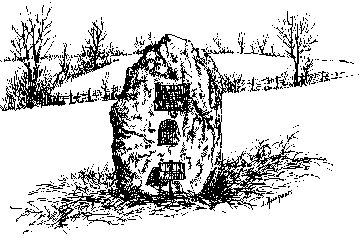On May 13-15, 1788, Stephen Keywood (or Cawood) hosted the first Methodist Conference held west of the Blue Ridge Mountains. It was to this conference that Francis Asbury was bound when he stayed with Edward and Sallie Cox for the first time.
The preachers met on the upper floor of Keywood’s log house; Asbury remarked that the room was cold and uncomfortable (there was only one fireplace in the house), but that the necessary business was completed.
The best remembered event of this conference actually occurred a few days before. It took several days for all the preachers to gather, and the early arrivals, including Francis Asbury, spent their time holding evangelistic meetings.
At one of these meetings, the preacher’s words deeply affected Elizabeth Campbell Russell. She invited him and two other preachers “to come and pray for us, and tell us what we must do to be saved.” The result was that Madam Russell and her husband were soundly converted to Methodism.
Elizabeth Russell (1749-1825) was the sister of Patrick Henry. She and her second husband, General William Russell, settled at Saltville, or “Salt Lick,” Virginia, and began a salt manufacturing business. The Russells were perhaps the most prominent citizens in the Holston area of Tennessee and Virginia, and their conversion had an important effect on the growth of Methodism in the area.
Seven years after her conversion (and two years after her husband’s death), Madam Russell freed her slaves, having concluded “that it is both sinful and unjust, as they are by nature equally free with myself, to continue them in slavery.”
After General Russell’s death in 1793, Madam Russell lived in Saltville until 1812, when she moved to present-day Chilhowie. She maintained a “prophet’s chamber” for visiting preachers, and provided them with a movable pulpit so that they could easily hold preaching services in her home. Francis Asbury stayed in the Russell home several times. On August 31, 1806, he noted in his journal: “I preached at the widow Russell’s; my hostess is as happy and cheerful as ever.”
The United Methodist Church in Saltville, Virginia, is named for Madame Russell. A log house modeled on the Russell home has been built next to the church.
Points of interest at this Heritage Landmark: The Keywood home had disappeared by 1916, when a stone marker was erected on the site, noting the site of the Keywood Conference of 1788.
There are no restroom facilities at the site. The marker is located in an open field, and parking is available.
Special events: None as of this writing.
Area attractions: Close by are Acuff Chapel and the Edward Cox House. In nearby Seven Mile Ford is the burial site of Madam Russell at Aspenvale Cemetery. In nearby Saltville is the Madam Russell United Methodist Church. Saltville and Glade Spring are in the foothills of the Appalachian Mountains.
To visit: The Landmark is on private property and you must contact the owner, George Rinchich, 817-915-9501, before visiting the site. Please remember to chain the gate when you exit.
Location: Within the boundaries of the Holston Annual Conference, in Washington County, Virginia. The Keywood marker is near Glade Spring.
Food and lodging: Restaurants and motels are available along Interstate 81.
Directions: From Interstate 81, take the Glade Spring exit (between Chilhowie and Abingdon) to Glade Spring. Follow Route 750 out of Glade Spring (crossing the railroad tracks) until the road forks. Continue on Route 750 for another half mile. The marker is 200 yards to the right (opposite a house).
To learn more about United Methodist church history in this area:
Holston Annual Conference Archives, Sherman Hall, Tennessee Wesleyan University, 204 E College St., Athens, TN 37303; 423-746-5226; E-mail: holstonconferencearchives@tnwesleyan.edu.
Emory S. Bucke, ed., The History of American Methodism, vol.1 (Nashville: Abingdon Press, 1964).
Nelly C. Preston, Paths of Glory; A Simple Tale of a Far-faring Bride, Elizabeth, Sister of Patrick Henry (Richmond: Whitlet & Shepperson, 1961).

